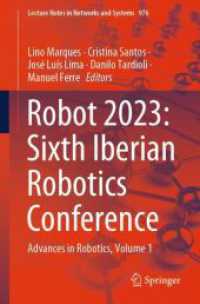- ホーム
- > 洋書
- > 英文書
- > Science / Mathematics
Full Description
Chaired by K Wüthrich (Nobel Laureate in Chemistry, 2002) and co-chaired by B Weckhuysen, this by-invitation-only conference has gathered 39 participants — who are leaders in the field of computational modeling and its applications in Chemistry, Material Sciences and Biology. Highlights of the Conference Proceedings are short, prepared statements by all the participants and the records of lively discussions on the current and future perspectives in the field of computational modeling, from chemistry to materials to biology.
Contents
The International Solvay Institutes; Solvay Scientific Committee for Chemistry; Acknowledgements; Participants; Auditors; Opening Address by Professor M Henneaux; Preface by Professor K Wuthrich; Discussions of Session 1: Artificial Intelligence/Machine Learning in Chemistry: Artificial Intelligence and Chemistry (A Aspuru-Guzik); Using Machine Learning to Learn Chemistry (T J Martinez); Synthetic Planning, Reaction Discovery, and Design of Chemical Systems Using Computers (B A Grzybowski); Merging Biophysical Mechanism and Evolution: Synergistic Approaches to Predict Evolutionary Dynamics to Fight Drug Resistance (E I Shakhnovich); Discussions of Session 2: Modeling of Functional Materials: Theoretical Modeling of Functional Materials (B M Weckhuysen); Operando Modeling of Functional Nanoporous Materials (V Van Speybroeck); Modelling Emergent Phenomenon Using Chemically Encoded Computations (L Cronin); Excited State Aromaticity for the Design of New Functional Materials (M Sola); Modelling Metal-Organic Frameworks and Other Functional Materials with Electronic Structure Theories (L Gagliardi and C J Cramer); Towards In-Silico Design of Functional Materials (K Stanciakova and B M Weckhuysen); Discussions of Session 3: Models and Experimental Data on Water Dynamic Complexity of Solid/Liquid Interfaces: Morphing Hard and Soft Bioinspired Materials by Reaction-Transport Dynamics (C N Kaplan and J Aizenberg); Understanding Molecular Transport Mechanisms at Water-Membrane Interfaces (S Keten); Active Nematics at Interfaces and Surfaces (J M Yeomans); Insight from Computational Approaches into Water at Well-Defined Solid Substrates (A Michaelides); Water at Interfaces: Where Theory Needs to Meet Experiment (M Bonn and Y Nagata); The Quest for Water Repellencies (T Mouterde, P Lecointre and D Quere); Discussions of Session 4: Computational Modeling in High-Resolution Imaging: Beyond the Physical Concepts: Computational Modeling in Fluorescence Nanoscopy (S W Hell); Parameter Estimation and Information Theory in Single Molecule and Superresolution Microscopy (R J Ober and M Vahid); Computational Modeling Enables Robust Multidimensional Nanoscopy (M D Lew); Converting Temporal into Spatial Information (J Enderlein); Data Fusion in Localization Microscopy (H Heydarian, M Bates, F Schueder, R Jungmann, S Stallinga and B Rieger); Multicolor, Dense and Volumetric Single Molecule Localization Microscopy and Point-Spread Function Design by Deep Learning (Y Shechtman); Reconstructing Embryonic Development from High-Resolution Light Sheet Microscopy Data (J Huisken); Discussions of Session 5: Modeling of Non-Equilibrium Systems and Simulation of Molecular Machines: Non-Equilibrium Systems & Molecular Machines (B L Feringa); The Importance of Correctly Modelling Catalysis for Understanding Molecular Machines (R D Astumian); On the Importance of New Computational Tools for the Construction of Functional Out-Of-Equilibrium Reaction Networks (W T S Huck); Modeling of Non-Equilibrium Systems: Reaction Networks for Bioinspired Behavior (A F Taylor); Simulation of Molecular Machines (B Hartke); Non-Equilibrium Steady-States in Artificial Supramolecular Materials (T M Hermans); Autonomous Chemically Driven Materials Systems Inspired from Life (A Walther); Discussions of Session 6: Computers in Interactive Structural Biology Leading to Modelling of an Intact Biological Cell: Introduction to Modelling of an Intact Biological Cell: Structural Biology, Fluorescence Microscopy and Computational Methods (T R Cech); Cryo-EM Visualization of Macromolecular Structure and Dynamics (E Nogales); Building Whole-Cell Computational Models to Predict Cellular Phenotypes and Accelerate Discovery (M W Covert and E Agmon); Towards High Resolution Intracellular Maps in Space and Time (M G Haberl, R Arrojo E Drigo, M W Hetzer and M H Ellisman);







